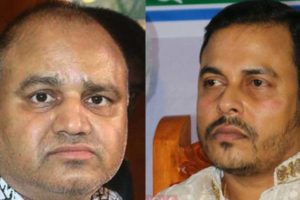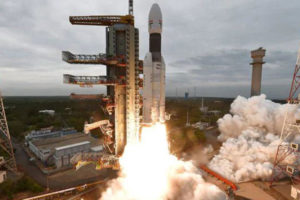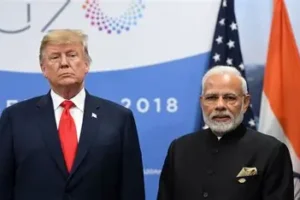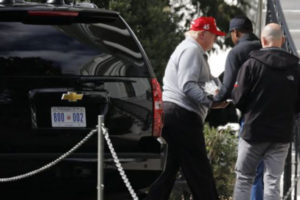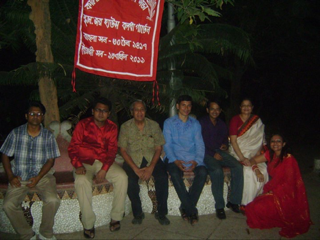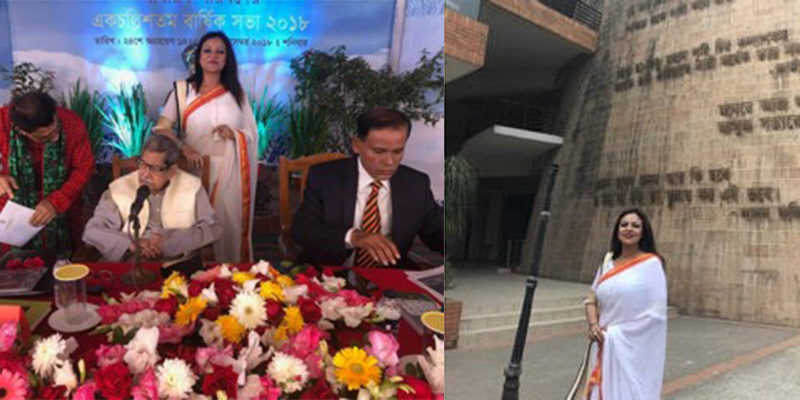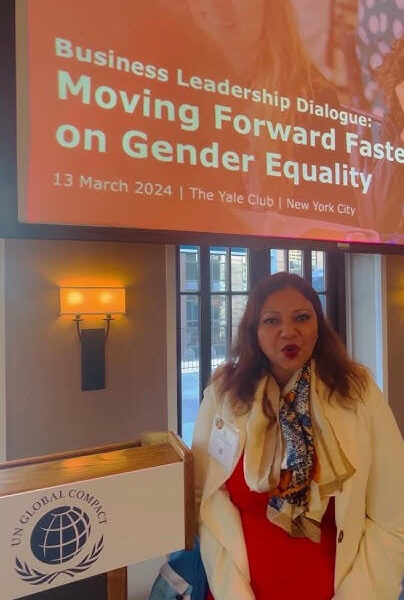President Donald Trump issued a violent ultimatum to protesters in Minneapolis on Friday and inserted himself in a harshly divisive fashion into the growing crisis there, attacking the city’s Democratic mayor and raising the spectre that the military could use armed force to suppress riots that erupted after the death of George Floyd, a black man, at the hands of a white police officer.
Trump’s threat to have unruly protesters shot — “when the looting starts, the shooting starts” — stirred an outcry in Minnesota and from his national critics, with his Democratic challenger in the presidential race, Joe Biden, expressing indignation that Trump was “calling for violence against American citizens during a moment of pain.”
The president framed his comments in explicitly ideological terms, as a denunciation of a liberal local government that had failed to maintain order, before abruptly retreating from them some 14 hours later in a slapdash effort to claim he had been misinterpreted. At an event in the Rose Garden on Friday afternoon, he made no mention of events in Minneapolis, took no questions and offered no acknowledgment of the spiralling conflagration over his initial outbursts on Twitter.
“I can’t stand back & watch this happen to a great American City, Minneapolis,” Trump wrote shortly before 1 a.m. Friday. “A total lack of leadership. Either the very weak Radical Left Mayor, Jacob Frey, get his act together and bring the City under control, or I will send in the National Guard & get the job done right.”
Trump’s mix of demands and attacks came despite the fact that Gov. Tim Walz of Minnesota had already activated and deployed the National Guard in response to a request from local leaders.
Trump began talking about the unrest in Minneapolis overnight as cable news showed a police station engulfed in a fire set by protesters. The four city police officers involved in the death of Floyd were assigned to that station.
Floyd was killed Monday after one of the officers, who were responding to a call about an alleged counterfeit bill used at a store, knelt on his neck while he was handcuffed and lying face down on the ground. Floyd called out, “I can’t breathe.” The officer, Derek Chauvin, and the three others were fired the next day. On Friday afternoon, Minnesota officials said that Chauvin had been arrested.
Trump, in his tweets, denigrated the protesters and issued demands in a situation that was already spiralling out of control.
“These THUGS are dishonoring the memory of George Floyd, and I won’t let that happen,” the president wrote in another post, which was flagged by Twitter. “Just spoke to Governor Tim Walz and told him that the Military is with him all the way. Any difficulty and we will assume control but, when the looting starts, the shooting starts. Thank you!”
In saying “when the looting starts, the shooting starts” Trump echoed a phrase coined by a Miami police chief in the 1960s about crackdowns on black neighbourhoods during times of unrest. Walter Headley, the Miami police chief in 1967, warned that young black men who he called “hoodlums” had “taken advantage of the civil rights campaign,” and added, “We don’t mind being accused of police brutality.”
Shortly before his event in the Rose Garden — a statement announcing punitive measures against China — Trump tweeted in a puzzling construction that his remarks overnight had been “a fact, not a statement” and said he had not been urging further violence but rather describing it as a natural consequence of looting.
Twitter officials appended Trump’s “shooting starts” tweet with a note saying the remark was “glorifying violence.” That provoked another tweet from the president accusing Twitter of having targeted “Republicans, Conservatives & the President of the United States” and prompting his aides to repost his original tweets on the official White House Twitter account. It was also flagged by Twitter.
On Friday afternoon, Biden condemned the president’s remarks, without naming Trump.
“This is no time for incendiary tweets,” Biden said over a livestream from his basement. “It’s no time to encourage violence.”
“The original sin of this country still stains our nation today, and sometimes we manage to overlook it,” Biden said. “We just push forward with a thousand other tasks in our daily life, but it’s always there, and weeks like this, we see it plainly that we’re a country with an open wound. None of us can turn away.”
In a statement posted on Twitter, former President Barack Obama described hearing anguished reactions from African Americans to the images of Floyd lying facedown with a knee on his neck. Obama said he shared their feelings.
“For millions of Americans, being treated differently on account of race is tragically, painfully, maddeningly ‘normal,’” in even the most ordinary situations, he said.
“This shouldn’t be ‘normal’ in 2020 America,” Obama said, calling for officials to investigate Floyd’s death and for all Americans to help end “the legacy of bigotry and unequal treatment.”
When the video of Floyd lying on the ground under the police officer’s knee first circulated, Trump called it “shocking,” and at the White House on Thursday press secretary Kayleigh McEnany said the president was “very upset” seeing it.
But the protests in Minneapolis have recalled some of the worst scenes of unrest in response to police brutality in the treatment of black men over the last 30 years.
President Trump, before signing an executive order regarding social media, in the Oval Office of the White House in Washington, on Thursday, May 28, 2020. Twitter said early Friday that a tweet from President Trump suggesting that protesters in Minneapolis could be shot violated the company’s rules against “glorifying violence,” in a move that threatens to escalate tensions between President Trump and his favorite social media megaphone over its content policies. (Doug Mills/The New York Times)President Trump, before signing an executive order regarding social media, in the Oval Office of the White House in Washington, on Thursday, May 28, 2020. Twitter said early Friday that a tweet from President Trump suggesting that protesters in Minneapolis could be shot violated the company’s rules against “glorifying violence,” in a move that threatens to escalate tensions between President Trump and his favorite social media megaphone over its content policies. (Doug Mills/The New York Times)When conflicts involving race has arisen during his presidency, Trump has often avoided taking a clear position. When neo-Nazis marched in Charlottesville, Virginia, in 2017 and a counterprotester was killed, Trump condemned the death but told reporters there were “very fine people” on “both sides” of the matter, prompting outrage. Biden referred to Trump’s comments about Charlottesville when he declared his campaign in 2019.
Trump’s hostility to black activists and his admiration of suppressive government force have been consistent features of his worldview for decades, stretching back even to a 1990 interview in which he spoke admiringly about the Chinese government’s crackdown on protesters in Tiananmen Square. (“That shows you the power of strength,” he told Playboy magazine.
The crisis in Minneapolis recalled scenes of police violence and civil unrest that scarred the 2016 presidential campaign, and that Trump seemed to use to his advantage in his contest with Hillary Clinton, his Democratic opponent. During the campaign, Trump criticised Black Lives Matter protesters seeking to call attention to police brutality, describing the activists as a “threat” in the summer of 2016.
A series of killings that summer — two incidents involving black men killed by police officers in Louisiana and Minnesota, and a mass shooting of police officers in Texas by a black gunman — set a bloody backdrop for Trump’s nominating convention and may have helped reinforce his law-and-order pledge to “make America safe again.”
Yet it was far from clear Friday that Trump’s instinct for the mailed fist would offer him comparable political rewards in his reelection campaign.
Americans typically expect their president to be not just an enforcer but also a unifier and a healer, roles that Trump has repeatedly shown no interest in performing. His threat early Friday morning to have unruly protesters shot exemplified his preference for escalating conflict, often in violent terms, rather than easing it.
Should scenes of violence, rioting and arson continue to dominate television screens in the coming weeks, it could ultimately make Trump’s brute-force message more appealing to some of the white swing voters who embraced him reluctantly in the 2016 election.
But that, too, might carry a political price: Trump’s campaign has been making selective efforts to reach out to black voters, particularly young men, and it is difficult to see how that pursuit could have the desired effect if the president demonises police protesters in harsh terms.
A burned building in Minneapolis, Thursday morning, May 28, 2020. A wave of protests erupted across South Minneapolis overnight and into Thursday, with the police firing tear gas and rubber bullets as people set buildings on fire and looted stores days after George Floyd, an African-American man, died in police custody. (Tim Gruber/The New York Times)A burned building in Minneapolis, Thursday morning, May 28, 2020. A wave of protests erupted across South Minneapolis overnight and into Thursday, with the police firing tear gas and rubber bullets as people set buildings on fire and looted stores days after George Floyd, an African-American man, died in police custody. (Tim Gruber/The New York Times)And as in other arenas of the 2020 campaign, Trump is confronting an elusive rival in Biden, who is one of only a few major figures left in the Democratic Party who can claim both a deep bond with black voters and a relatively conservative record on matters of law enforcement.
At a virtual fundraiser Thursday, Biden opened his remarks with a sombre reflection on Floyd’s death, calling it a “brutal, brutal death.” He described the nation as struggling with “an open wound” and nodded to “an ingrained systemic cycle of racism and oppression” in America.
“It’s ripped open anew this — this ugly underbelly of our society,” he said.
Black activists and political groups responded to Trump’s statements with shock, accusing the president of using race as a political wedge at the expense of vulnerable communities. They pointed to Trump’s previous statements regarding protesters in Charlottesville as a counterexample, saying that his willingness to defend protesters who included racist and anti-Semitic individuals in 2017 did not extend to black protesters in Minneapolis.
Progressive groups said that the protests and actions in the Minneapolis community should not be seen in isolation, but a culmination of sustained police aggression and systemic inequality — present long before Floyd’s death.
“This is a clear representation of a president who has always seen those who stand up to injustice as enemy combatants, and has been uninterested — at every turn — in the role of uniting people,” said Rashad Robinson, president of Color of Change, a racial justice organisation.






